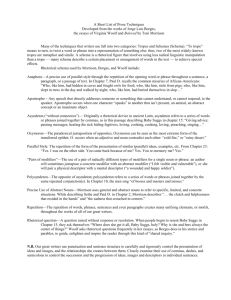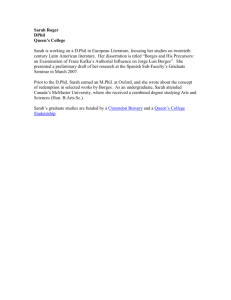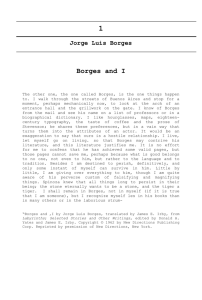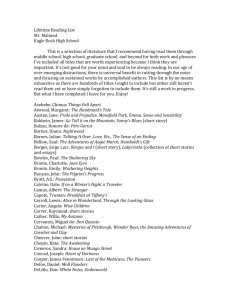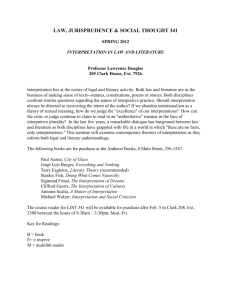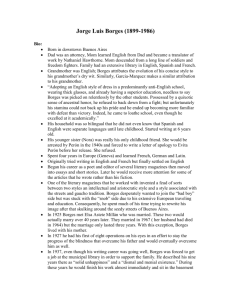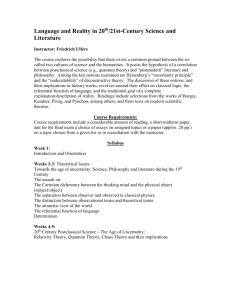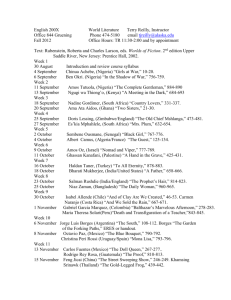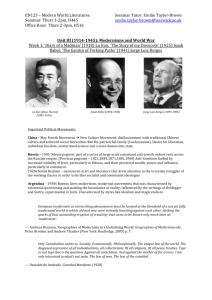A Short List of Prose Techniques
advertisement
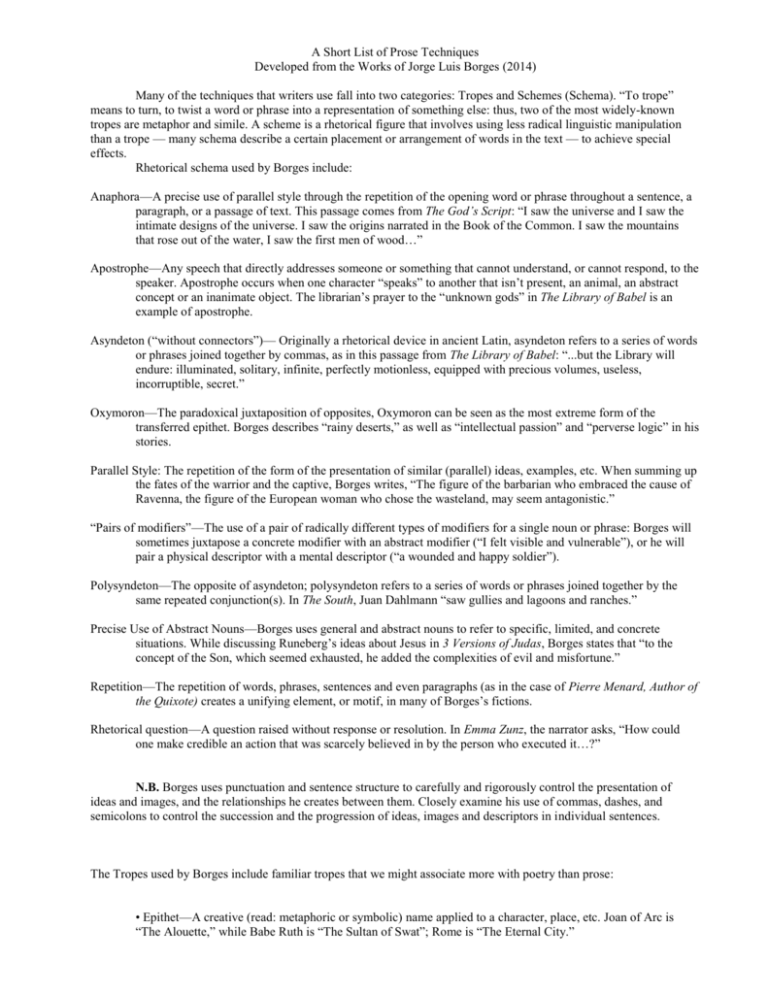
A Short List of Prose Techniques Developed from the Works of Jorge Luis Borges (2014) Many of the techniques that writers use fall into two categories: Tropes and Schemes (Schema). “To trope” means to turn, to twist a word or phrase into a representation of something else: thus, two of the most widely-known tropes are metaphor and simile. A scheme is a rhetorical figure that involves using less radical linguistic manipulation than a trope — many schema describe a certain placement or arrangement of words in the text — to achieve special effects. Rhetorical schema used by Borges include: Anaphora—A precise use of parallel style through the repetition of the opening word or phrase throughout a sentence, a paragraph, or a passage of text. This passage comes from The God’s Script: “I saw the universe and I saw the intimate designs of the universe. I saw the origins narrated in the Book of the Common. I saw the mountains that rose out of the water, I saw the first men of wood…” Apostrophe—Any speech that directly addresses someone or something that cannot understand, or cannot respond, to the speaker. Apostrophe occurs when one character “speaks” to another that isn’t present, an animal, an abstract concept or an inanimate object. The librarian’s prayer to the “unknown gods” in The Library of Babel is an example of apostrophe. Asyndeton (“without connectors”)— Originally a rhetorical device in ancient Latin, asyndeton refers to a series of words or phrases joined together by commas, as in this passage from The Library of Babel: “...but the Library will endure: illuminated, solitary, infinite, perfectly motionless, equipped with precious volumes, useless, incorruptible, secret.” Oxymoron—The paradoxical juxtaposition of opposites, Oxymoron can be seen as the most extreme form of the transferred epithet. Borges describes “rainy deserts,” as well as “intellectual passion” and “perverse logic” in his stories. Parallel Style: The repetition of the form of the presentation of similar (parallel) ideas, examples, etc. When summing up the fates of the warrior and the captive, Borges writes, “The figure of the barbarian who embraced the cause of Ravenna, the figure of the European woman who chose the wasteland, may seem antagonistic.” “Pairs of modifiers”—The use of a pair of radically different types of modifiers for a single noun or phrase: Borges will sometimes juxtapose a concrete modifier with an abstract modifier (“I felt visible and vulnerable”), or he will pair a physical descriptor with a mental descriptor (“a wounded and happy soldier”). Polysyndeton—The opposite of asyndeton; polysyndeton refers to a series of words or phrases joined together by the same repeated conjunction(s). In The South, Juan Dahlmann “saw gullies and lagoons and ranches.” Precise Use of Abstract Nouns—Borges uses general and abstract nouns to refer to specific, limited, and concrete situations. While discussing Runeberg’s ideas about Jesus in 3 Versions of Judas, Borges states that “to the concept of the Son, which seemed exhausted, he added the complexities of evil and misfortune.” Repetition—The repetition of words, phrases, sentences and even paragraphs (as in the case of Pierre Menard, Author of the Quixote) creates a unifying element, or motif, in many of Borges’s fictions. Rhetorical question—A question raised without response or resolution. In Emma Zunz, the narrator asks, “How could one make credible an action that was scarcely believed in by the person who executed it…?” N.B. Borges uses punctuation and sentence structure to carefully and rigorously control the presentation of ideas and images, and the relationships he creates between them. Closely examine his use of commas, dashes, and semicolons to control the succession and the progression of ideas, images and descriptors in individual sentences. The Tropes used by Borges include familiar tropes that we might associate more with poetry than prose: • Epithet—A creative (read: metaphoric or symbolic) name applied to a character, place, etc. Joan of Arc is “The Alouette,” while Babe Ruth is “The Sultan of Swat”; Rome is “The Eternal City.” • Hyperbole—Obvious over-exaggeration. • Metaphor (including personification)—Remember to look for the “noun of (different) noun” construction. • Simile — Look for “like, as, so or (even) than.” Here are the more strictly “prosaic” Tropes Borges uses: Hypallage—The use of one adjective and a pair of nouns, usually in the form “the adjective noun of noun.” In this device the adjective (or other modifier) that would “logically” modify one of the nouns is applied to the other noun in the same phrase. The poet John Keats uses a hypallage when he describes “the murmurous haunt of flies.” Borges writes of the “desperate hands of the thief,” and he describes a young girl by using a hypallage: “She shook her doubtful curls.” N.B. Hypallages are easily confused with transferred epithets; look for the “two nouns” in the phrase to make sure you’re dealing with a hypallage… Litotes—Borges frequently expresses an idea by negating its opposite: “Within a few days no one was unaware of the fact that the silent man came from the South.” About his story The Lottery in Babylon, he once wrote that it is “not entirely innocent of symbolism”; he states elsewhere that mirrors are sometimes troubled by the breath of a man “who is not dead.” Metaphoric Use of Verbs—The use of verbs, which do not “logically” describe the situation at hand, but which illuminate that situation. In Tlön, Uqbar, Orbis Tertius, there is a mirror that “troubles the depths of a corridor”; later in the story the characters discover that the mirror is “spying” on them as they talk. Metonymy—The substitution of a word by a word closely related to it, as in the phrase, “The Vatican did not respond well to Moscow’s offer of help,” in which we have substituted the names of capital cities for the authorities they represent. We use metonymy whenever we tell someone to “come inside out of the cold,” since we substitute one attribute of the outside world (the low temperature) for the outside itself. Borges, describing the fall of the city of Connaught, uses metonymy when he writes, “Tall, silent horsemen patrolled the roads; ashes and smoke rode the wind…” here, ashes and smoke (the effects of fire) are used to represent fire itself (the cause that produced the ashes and smoke). Symbolic (“Canted”) Names—The use of a symbolic or otherwise meaningful name for a character, a setting, etc. The name of Ireneo Funes, the main character of Funes the Memorious, derives from the Spanish word “funesto,” meaning a disaster; the idea that this man has a “disastrous memory” is one of the key themes of the story. Synecdoche—Often regarded as a special type of Metonymy, synecdoche is a substitution of a part of something for the whole, or (sometimes) the whole for the part. Speaking of the fleet that sailed to re-capture Helen of Troy, Homer uses the synecdoche “1000 sails” to describe the 1,000 ships. Borges uses synecdoche when one of his characters states that “…I had to flee from Captain Madden. His hands and his voice could call at my door at any moment.” Here, he uses parts of Captain Madden to represent the man himself. Transferred Epithet— The use of an adjective (or other modifier) that does not “logically” modify the noun to which it refers, but which nonetheless illuminates that term, creating a new phrase with expanded (and perhaps metaphoric) meaning. One of the “most famous” transferred epithets comes from Shakespeare’s Macbeth: “dusty death.” Borges, in his Garden of Forking Paths, describes an “unsuspected light” and a “dreaded window.” N.B. Borges uses all of these techniques to create the following effects: —Ambiguity —Contradiction —Discontinuity —Duplicity —Irony (although there are those who argue that irony is a technique; we’ll discuss this together in class) —Paradox
